
Tort's Camping FAQ
Updated June 2007Please wait for the whole page to load before following any of the links below, in order that they will take you to the right place. Alternatively just scroll down the page to read the entire FAQ.
- Introduction
- What sort of tent should I buy?
- How much should I spend?
- How big should my tent be?
- What Are "Hydrostatic Head" and "Sun Protection Factor"?
- What else should I look out for?
- What about sleeping bags etc?
- What other gear should I take?
- Are the campsites separate from the Festival?
- Where is the best place to camp?
- Where can I get more advice on which field is best?
- Can I save space for my mates?
- Any other tips?
Introduction
 Hello. You may have read the rather lengthy Frequently Asked Questions (FAQ) piece that I've done. This is really just a little bolt-on to that to cover all those questions that crop up regularly on the Camping Arrangements Message Board of the Official Glastonbury Website with specific regard to camping at Glasto. A bit further down you'll find some ideas and advice on where you will find the best places are to pitch your tent at the Festival but let's take things in chronological order for those who are new to all this Festival business.
Hello. You may have read the rather lengthy Frequently Asked Questions (FAQ) piece that I've done. This is really just a little bolt-on to that to cover all those questions that crop up regularly on the Camping Arrangements Message Board of the Official Glastonbury Website with specific regard to camping at Glasto. A bit further down you'll find some ideas and advice on where you will find the best places are to pitch your tent at the Festival but let's take things in chronological order for those who are new to all this Festival business. What Sort Of Tent Should I Buy?
There is a vast and bewildering selection of tents on the market these days. Most are the nylon dome variety with carbon fibre poles but they do vary hugely in size and quality and also, therefore, in price.Alternatively you could look into a more traditional canvas army style or bell tent or, if you are really adventurous, a tipi. However don't forget that these are invariably far more complex to construct than contemporary designs and are much heavier to transport and carry to your campsite, which at a large festival like Glastonbury is a very important factor.
There are an increasing number of instant "pop up" tents on the market which initially I felt were rather gimmicky and not for the serious festival camper. However some people do rave about them & they appear to be coming down in price so they may be worth considering.
There are also "Cardboard Tents" now available which are only designed to withstand all weathers for a single festival. The outer skin of treated cardboard is then disposed of while the inner frame is recycled. They are very pricey however & you could easily buy a good 4 man tent which will last you years for the same outlay.
How Much Should I Spend?
When it comes to buying a festival tent the cheapest option is very rarely the best. Admittedly there is a good chance that it will suffer a degree of wear & tear through cigarette burns, people tripping over guy ropes and getting it covered in mud & wax from flares. But I would nevertheless advise against viewing your tent as being a disposable commodity. My last one survived no less than 17 summers, which worked out at considerably less than £1 a festival, and my current tent is already a veteran of more than 25 different events.
You will find many shops selling 2-man tents for as little as £15. But a cheap tent will invariably equate to flimsy poles, poor waterproofing and insufficient anchorage and whilst these factors may not inconvenience you too greatly in fine weather, they certainly will if we get a repeat of the stormy conditions that we have experienced over the last couple of festivals. There is nothing worse than waking up in a tent that has either leaked or collapsed in the night. It can literally ruin your festival. A little extra expenditure at the outset, however, will get you a tent that will keep you dry & should last several summers of festivals with relatively little maintenance.
How Big Should My Tent Be?
Tents are generally categorised by the number of people the manufacturers consider they should be able to accommodate. Don't believe a word of it! A 4-man tent may sleep a family with 2 small children in relative comfort but it certainly won't have room for 4 fully grown adults together with all their gear for a 5-day festival. Follow this general rule of thumb for the number of people that can comfortably be expected to sleep in each size of tent.2-man sleeps 1
3-man sleeps 2
4-man sleeps 2
5-man sleeps 3 (or in my case 1 plus lots of beer and occasional vagrants)

What Are "Hydrostatic Head" and "Sun Protection Factor"?
When you are searching the internet or browsing through camping shop brochures for tents you may well find reference to a tent's "hydrostatic head". In layman's terms this is basically a number that indicates how much rain a tent can withstand before it is likely to start leaking. The higher the number the greater a tent's waterproofing qualities. Look for tents that have a hydrostatic head rating of 2,000 or more and you are pretty much guaranteed to stay dry even if we see a repeat of 2005's torrential downpours.Some tents are also supplied with a sun protection factor. Technically it is possible to get sunburnt inside a tent & much like the stuff you slop all over yourself on the beach this gives an indication of how many more times longer you are able to lie there without getting burnt than you would do in direct sunlight. To be honest I've never seen the point of this because if the sun is beating directly on your tent in late June then it becomes virtually uninhabitable by 8am so you're far more likely to roast than you ever are to fry.
What Else Should I Look Out For?
Most tents nowadays come with an outer "fly" sheet larger than the inner tent, thereby creating a porch at the front of the tent. This is useful for storing wet gear & muddy boots so you can keep your sleeping area clean & dry.Try to get a tent which is erected outer sheet first. My current festival tent has this advantage and it means that I can pitch it in a downpour without getting the inner tent wet. Once the outer tent is up and secured you simply clip the inner tent to the poles & peg down the groundsheet.
Look out for poor stitching both on the seams and also the anchorage points. Do all of the poles, zips, hooks etc. look man enough for the job?
Make sure the tent is well ventilated. Many come with a cowl that fits over the top of the outer tent to allow condensation to escape but make sure that you don't lose this or the top of your tent will be open to the elements next time you use it.
Windows are fine for getting additional light into a tent but they do tend to be the first place that leaks so best to be avoided.
Make sure that the pegs are a decent length. A lot of tents come with 6" pegs as standard but you'll find that these could well pull loose in high winds. It would be as well to replace these with more beefy 9" pegs for the main anchor points around the outer tent.
Fluorescent guy ropes are handy to prevent people tripping during the night.

What About Sleeping Bags etc?
Again there is a large variety of Sleeping Bags available on the market and they are generally rated by the number of Seasons for which they could be used. A 1 Season Sleeping Bag will only be a lightweight bag designed specifically for camping in warm summertime weather whereas a 4 Season Bag is likely to be bulky but will keep you toasty warm in sub-zero conditions. You may find that some camping shops give an indication of the ranges of temperatures for which you will be able to use them in optimum comfort and also the maximum & minimum temperatures at which they could be used safely.Don't forget that although Glastonbury takes place in mid-Summer it can still get very chilly at night and we have experienced temperatures very close to freezing in the past. A 2 or 3 Season Sleeping Bag would therefore be a sensible option. You can always put additional clothes on if you are cold or unzip the bag if you get too warm. You lose far more body heat into the ground than you do into the air so an airbed, camping mat or blanket underneath your sleeping bag will add to the insulation as well allowing you to sleep more comfortably on rough ground.
Don't forget that weight is an issue as you may have to carry your gear several miles at Glastonbury so try not to buy a sleeping bag that is too heavy. Also most modern bags come with a compression sack which allows you to squeeze the air out and minimise bulk in your rucksack. Make sure you have one of these.
Many people take duvets as an alternative to Sleeping Bags but naturally these are far more bulky and transporting them to your campsite can be a major headache if you don't have a proper waterproof bag to carry them in. My recommendation would be to leave your duvet at home & only use it for festivals where you can camp close to your car.
Ordinary feather or foam pillows are far too cumbersome to bother with but you can get blow up pillows. Alternatively a folded jumper does the job just as well.
If you take an airbed make sure you also have something to pump it up with. Manual or Electric pumps are available fairly cheaply or alternatively you can get airbeds which have a pump incorporated into them.
What Other Camping Gear Should I Take?
MalletSpare Pegs
String
Duct Tape for temporary repairs to split poles
Pen Knife or Multi-Purpose Camping Tool
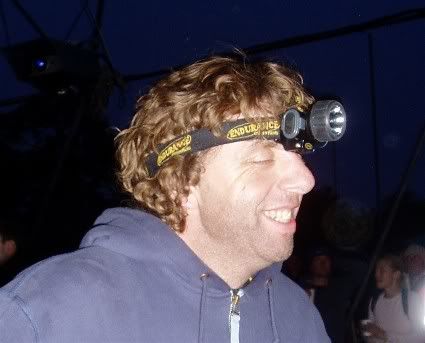
Don't forget that if you arrive on the Thursday evening it could take you several hours of queuing to get into the car parks and at the entrance gates. You may therefore end up putting your tent up in the dark so a good torch is essential. If you don't have a spare pair of hands to hold the torch for you one of these head torches is useful, if not particularly flattering dancefloor attire.


If you do manage to leave anything at home or if you need to make repairs to your tent during the festival there are camping shops onsite who should be able to supply you with most things you might need. Prices are a little higher than your local Milletts but not extortionate. The 2-man tent in the picture was only £25 (in 2004).
Are The Campsites Separate From The Festival?
Glastonbury differs from festivals like Reading and V in that, with the exception of the Car Parks and the Campervan Fields, the whole festival is within the fence. Once you enter through the gates, you don't have to leave again until the Monday. You can camp in any of the designated public camping areas provided they have not already reached their allotted capacity.Where Is The Best Place To Camp?
This is a perennial question on the Message Boards and so a couple of years ago I went for a tour around the site taking pictures in the various camping fields so that I can actually show you what they are like rather than having to describe them. Unless stated otherwise these photos were taken early afternoon on the Thursday so they will give you a good idea of how full the various areas are at that stage. I'm afraid after I had got 2/3rds of the way round the call of the Cider Bus became too great and as a result I never got around to snapping Holts, Dance & Oxlyers Fields or Pennard Hill so thanks to Wiskey for helping me out with the latter. If anybody does have any photos I could borrow of the fields that are missing please contact me by Personal Message.
I'm afraid after I had got 2/3rds of the way round the call of the Cider Bus became too great and as a result I never got around to snapping Holts, Dance & Oxlyers Fields or Pennard Hill so thanks to Wiskey for helping me out with the latter. If anybody does have any photos I could borrow of the fields that are missing please contact me by Personal Message. None of what follows is going to make an awful lot of sense to you unless you can relate it to a map of the Festival site. So Click Here for a high resolution version of the map (2.2mb) of how the site was laid out in 2004 or Here for a less memory intensive (220kb) version. We'll work our way anti-clockwise around the site starting in the top right hand corner.
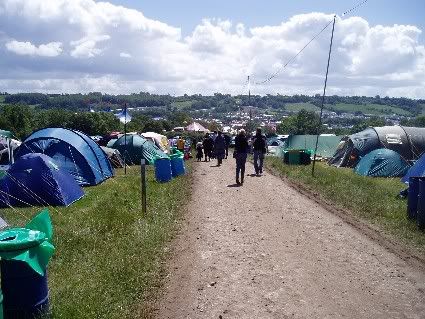
There is a large area to the north east of the site which is specifically reserved for Family Camping. There is no designated ratio of adults to children in any group so friends without children will be able to camp with you but please bear in mind that this area is popular and space is limited so people without kids in tow should look elsewhere.
The Family Field is entered almost immediately from Gate B but this is quite difficult to access for the majority so alternatively use the Eastern (Blue) Car Parks and enter the site at Gate C, turning right at Leftfield and the Meeting Place and continuing up the track known as "Muddy Lane". It's a long hike from the Western Gates A and D.
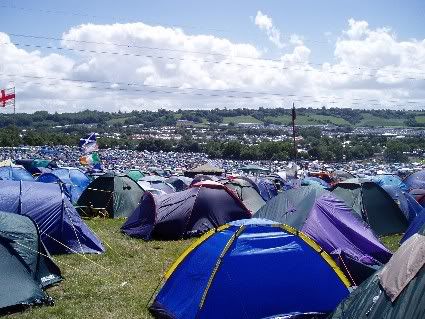
This Photo is taken from the top of Big Ground and also looks down over the flatter areas of Kidney Mead and Row Mead.
Big Ground, Home Ground and the other fields on the hill that overlook the Pyramid Stage tend to fill up fairly rapidly. These are popular with those who like to watch the bands from the comfort of their tent.
Again Gates B and C to the East of the site probably offer the quickest and easiest access to these areas.
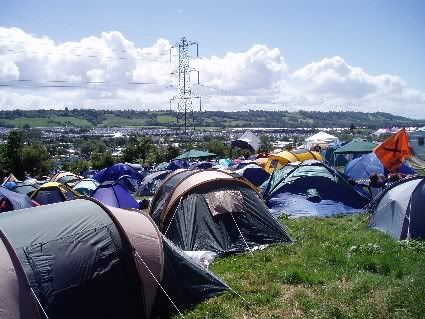
This is taken from the eastern end of Home Ground, near to the farm, looking toward the Pyramid Stage
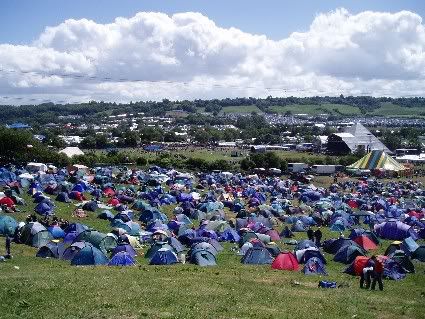
This is Michael's Mead looking down toward the Pyramid across Top Webb's Ash. Again, excellent views of the Pyramid and beyond but extremely steep toward the top of the hill.
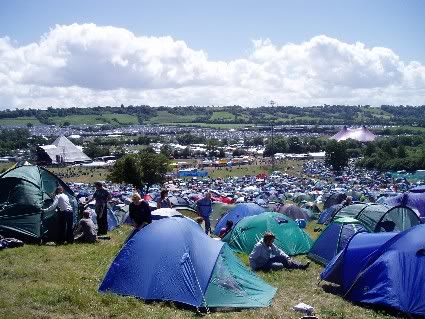
Still in Michael's Mead this looks down toward Spring Ground, the Disabled Camping Area and the Dance Tent (now replaced by the Dance Area) beyond. To the left of that in the distance you can see the Dance Field and Oxlyers Camping Fields. Beware that the Cinema shows films until 4am each night so if you need your beauty sleep try not to camp too close to this area.
The Disabled Camping area is reserved for people with permanent disabilities and their carers. Vampthing has done a special piece regarding Disabled Camping and the facilities available there as part of her "Glasto Onna Stick" guide. You can read it by clicking here. In 2007 the Disabled Camping area will be moving to take up the lower portion of Spring Ground.
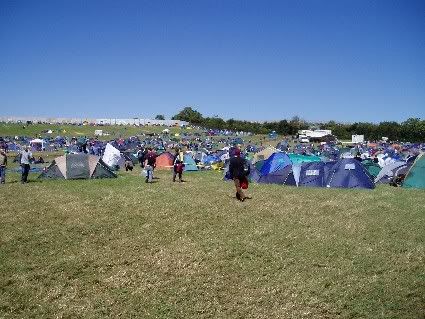
The least populous area tends to be in the extreme Northwestern corner of the site between the farm and Gate A. You'll certainly find the quietest camping areas here and plenty of space but you will also be camped on quite a steep hill. The photo above is of Hitchin Hill. Wicket Ground and Lime Kiln Ground are the other fields in this area. The top of Spring Ground will be given over to form a second Family Camping area for 2007, thereby making life easier for families arriving by coach or entering from the Western Car Parks.
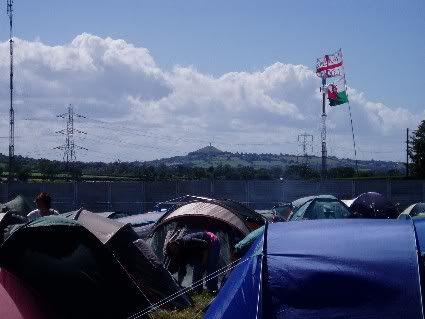
The first field you come into if you enter via Gate A is Woodsies, which, as you can see, offers splendid views of Glastonbury Tor.
The flattest camping areas can be found in the Dance Field and Oxlyers although personally I find these areas rather soulless and tend to avoid them. Certainly it is noticeable how much more litter is left in these areas at the end of the festival so draw your own conclusions, and as they are low-lying they are the most likely to get muddy if it's wet.
On the plus side, these fields do give very easy access to The Other Stage, Dance Area and John Peel Tent, as well as being a relatively short walk from The Pyramid and The Glade. They are also easily accessible from either Gate A or D so if you are arriving by bus or park your car in the Western Car Parks and you don't fancy a long hike with all your gear then this may be the place for you.
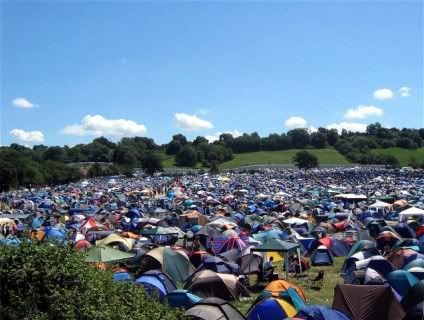
The largest open camping areas are Home Park Ground & Pennard Hill Ground, which are collectively known as Pennard Hill. These can be found to the Southwest of the site and are becoming increasingly popular without being too overcrowded. Pennard's Hill is very convenient for the Other Stage, which is just over the disused railway track, and also for The Green Fields and The Sacred Space which are right next door.
Access to Pennards Hill is fairly handy for those using the Western (Red) Car Parks and entering via Gate D but is a long hike from all of the other gates.
Wiskey's photo above was taken on the Friday and shows Pennard Hill Ground from the disused railway track with the Sacred Space just visible to the top left.
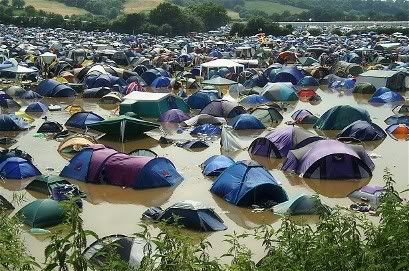
Unfortunately the bottom of Pennard Hill is the camping area that suffered worst from flooding as a result of the massive thunderstorm that struck on the Friday morning in 2005. As you can see from this photo taken by Bob Rose the deluge flowed down the hill until its escape into the River Whitelake was blocked by the railway embankment at the bottom of the hill. Major drainage work has been undertaken to alleviate the problem should we be so unfortunate to have a repeat of this extreme weather in future years.
With the increase in capacity approved for 2007 the majority of the additional 27,500 people will be accommodated in the Park Farm area which previously lay outside the fence to the West of Home Park Ground. The impression I have is that this will create an enormous unbroken tented City when added to the existing campsites which should be a very impressive sight.
Holts is dead central and therefore handy for all areas but is however rather noisy with the Glade nearby and sound systems playing in some of the market stalls 24 hours a day. A pair of earplugs is advisable if you intend to stay here & hope to get a decent night's sleep, although it certainly isn't quite so full on nowadays as it was the last time I camped there in 2000.
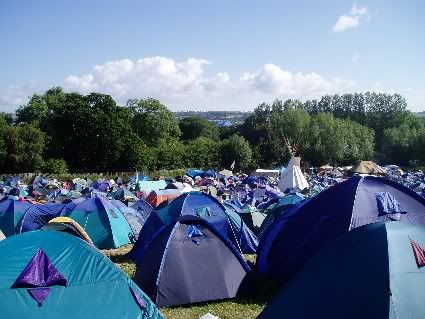
From a personal perspective I love the Greenfields camping area in the extreme south eastern corner of the site but with the expansion of Lost Vagueness and crew camping in recent years a large chunk of this area has become out of bounds to punters for camping. As a result stewards start turning people away from the only remaining camping fields in this area (Dragon and William's Fields) just a few hours after the gates open on the Wednesday morning!
The picture above is Dragon Field on the Friday morning looking down toward Lost Vagueness. Home base for me for the last couple of festivals. Note however the large army style tent at the bottom of the field which kicks out techno until the early hours and isn't an ideal neighbour for early-to-bedders.
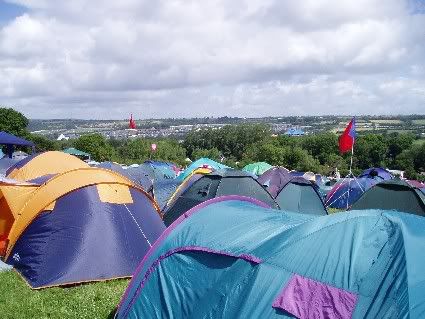
This is William's Field where I camped in 2003. You can just make out the Pyramid (to the left) and the Acoustic Tent (to the right) in the distance.
Access to Dragon & William's Fields is a fairly long hike from any of the gates but I tend to head for the Western Car Parks, enter via Gate D and then just bomb along the disused railway line before hanging a right up the hill just before the turning into Lost Vagueness. If you are coming in from the East and entering via gate C then turn left, through the Theatre, Cabaret & Avalon Fields.
Where Can I Find More Advice On Which Field Is Best?
Everybody's opinion as to what makes an ideal camping spot is different so don't take my word for it. In the run up to the 2003 festival a number of people on the efestivals website volunteered information and opinions (good and not so good) on the various places that they had camped at Glastonbury.With massive thanks to Staberinde who created this little gem and VVT whose idea this originally was Click Here and look for the "Boarders" Comments Section for the independent views of some 85 Glasto veterans as to where the best places to camp can be found.
If you are still not certain where you want to head for when you arrive at the site ask the stewards who should have up to date information as to which areas have already reached their maximum capacity. If you are told by a steward that a field is full don't try to sneak in anyway. The festival has been heavily criticised for overcrowding in the past and the resulting safety concerns have been an issue at the annual license hearing. So if you camp in a field that is already "full" you are effectively jeopardising the future of the festival.
Can I Save Space For My Mates?
If you are hoping to camp with friends but are arriving at different times it is preferable to take their tents with you and put them up for them rather than try to save space. Many people frown on the practice of taping off areas and I have to admit that I feel that it is rather anti-social and goes against the tremendous community spirit that otherwise prevails at the Festival.If you must tape off an area for friends who are arriving later, head for one of the less popular camping fields where space isn't going to be at such a premium. It would be polite to put up signs around your patch saying something along the lines of "Space saved for friends arriving Friday, Thankyou". Your neighbours are less likely to think you're just being greedy. Also make sure that the tape you use is highly visible to prevent tripping and don't tie it to your tent so that if somebody does trip over it they won't take your tent down with them.
Any Other Tips?
Before you leave home make sure you have at least one dummy run at putting your tent up and try to familiarise yourself with the process so that you can erect your tent without needing to read the instructions. Don't forget that when you get to the festival you may have to put your tent up in a limited amount of space and possibly windy or rainy weather. It could even be dark.If you've used your tent before it's still a good idea to put it up before you leave home to make sure that it hasn't perished and that none of the parts have gone missing.
Try to pitch your tent away from toilets and pathways if you want to avoid smells & having your tent trampled into the ground.
If at all possible pitch your tent with the door facing downhill and/or away from the prevailing wind. This will prevent a pool forming in your porch if it rains or the wind gets up. It's also much more comfortable to sleep with your head uphill.

Not all guy ropes are essential in anything other than stormy conditions and the more you have pegged out the more likely people are to trip over them & damage your tent.
Don't padlock your tent - See the Security section in the main FAQs via the link at the top of this page.
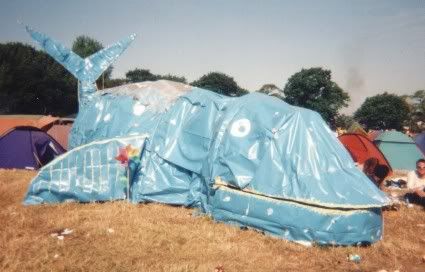
If you want to have a bit of a lie in every morning then try to pitch your tent to the West of trees, hedgerows or other large structures so that your tent is shaded from early morning sunlight. Alternatively some tents are made from reflective material and tend to stay cooler for longer. Covering your tent with foil or pitching it under a gazebo, parachute or camouflage netting are other ways of keeping your tent cool & shaded.
Before leaving your tent make sure that there is a landmark nearby to use for navigating your way back again. In 2000, having put my tent up in the dark, I woke up to find this "Big Fish" next door. The tail was 10ft tall so I had no problems finding my way home. Many people make their own flagpoles but try to think of something a little more original than the ubiquitous Cross of St George.
When you get home make sure you take your tent out of its bag and air it before stowing it away. Mildew can start to form on a wet tent within just a few days.
Finally I recommend you look at Wiskey's additional and very sound advice Here.

Have fun!
Tort
 - Tort's Fezzy Photos
- Tort's Fezzy PhotosThis page last updated: 01 September 2022

If you have a comment, please leave it in the guestbook. To contact Flash directly, complete this form. Like this site? Buy me a drink!
This site moved from a fixed width to the current layout in 2009. Some older content such as photo sets may still have a fixed width. However if you notice any pages which are actually broken, please be kind enough to let me know via this form.
© Flash Wilson 1999-2010. I charge a fee for use of my photos.
